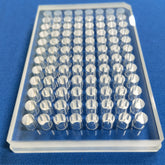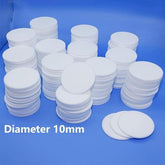Precautions for installing quartz crucibles
A quartz crucible is defined as a cup-shaped vessel utilized within a laboratory for heating solids at elevated temperatures. Its application is not restricted by factors such as production scale, batch size, or the type of substance to be melted, so its selection is entirely discretionary. It is characterized by its strong applicability and capacity to ensure the purity of the substance being smelted.
When installing quartz crucibles, the following points should be noted:
1. Before installation, the interior of the furnace chamber must be inspected
The furnace wall and the bottom should be intact, with no metal or slag adhering to the surfaces. In the event of cement or slag adhering to the furnace wall or the bottom, it is imperative that the affected area is thoroughly cleaned. Otherwise, the forward movement of the flame may be impeded, resulting in a deviation in its trajectory. This can lead to excessive local heating and oxidation, or the formation of minor holes on the crucible wall.

2. Bottom support
(1) In the process of installing quartz crucibles, it is imperative that the base support be of sufficient size, and of a cylindrical shape. The diameter of the base is a minimum of that of the crucible bottom. In general, it is 2-3cm larger than that of the crucible bottom. Additionally, the height of the base should be slightly higher than the fire. This prevents the flame from reaching the crucible bottom directly, thereby avoiding the rapid erosion of the bottom material and the consequent transformation of the crucible into a cone shape. Alternatively, the uneven distribution of force across the bottom may result in crucible cracking.

(2) To prevent adhesion to the base, a layer of isolation material (such as fine refractory sand or cardboard) can be placed between the crucible bottom and the base.
(3) In the context of utilizing a button-type base within a tilting furnace, it is imperative to ensure that the protrusions of the base and the grooves of the crucible match each other. In the event of an excessively high protrusion of the base or an unduly large size, the crucible bottom will be compressed, which will inevitably cause it to crack, and, in the event of a tilt, this will be difficult to rectify.
(4) When installing a tilting furnace with a long spout, it is imperative that a base of the appropriate height is provided. This base must be supported and fixed properly to ensure the furnace’s stability and safety. If the base is not supported properly, such products will only be “suspended” inside the furnace by the spout. This will break off from the top.






